
Cal Sailing Club Wins Appeal to Remain at J-Dock
When Berkeley’s Cal Sailing Club (CSC) received notice last May that they were to be relocated from J-Dock at Berkeley Marina, where they have been based for over 50 years, to make room for 40-ft boats, the club was concerned that the move would “kill” their program — docking maneuvers would be more hazardous and could lead to the club’s sailing program being shut down. Members and the community took action and rallied together to try to keep the club’s operations at its existing base. Last week their efforts were rewarded.
“I am very happy to share the good news that we’ve been successful in our campaign, and the Berkeley City Council voted to protect Cal Sailing Club in its historic location on J-Dock at the Berkeley Marina and dedicate those berths to sailing instruction (as long as we continue to do the Community work we do),” wrote CSC’s co-commodore Nicholas (Nicho) Waton. He then told us about the scores of letters (over 100) that members and the supporters sent to the council on the club’s behalf.
“We were also able to take many of them out for a sail, and some of them are very tempted to start taking lessons,” Nicho added.
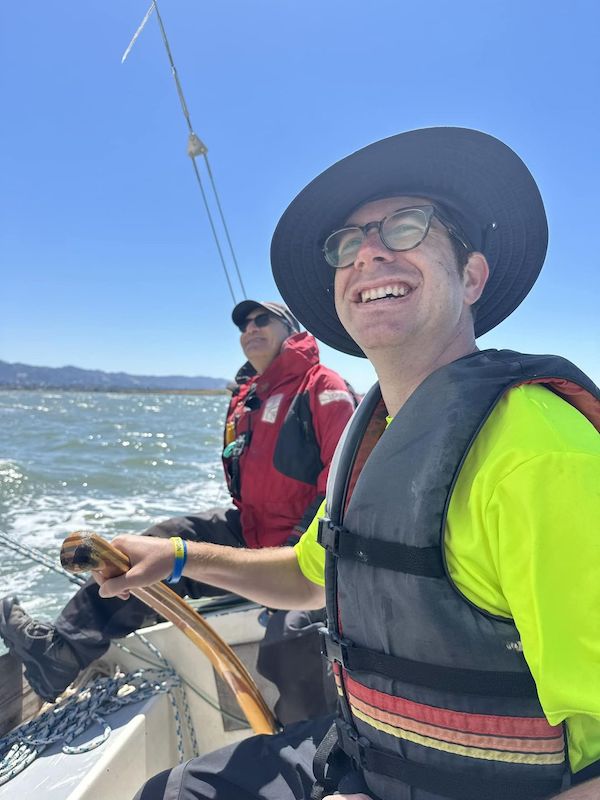
Councilmember Terry Taplin is a member at Cal Sailing Club. When the club received the notice of relocation, he took measures to help save the organization, proposing a resolution that would see the six J-dock slips in question dedicated to teaching safe boating, community and education.
“He had a very poignant personal story,” Nicho continued. “He grew up near the waterfront but had never been on the water and had a fear of it. He was able to overcome his fear and is now really enjoying the process to learn how to sail. He’s been volunteering during our Open Houses (he joined the last three this year and will be there Sunday).”
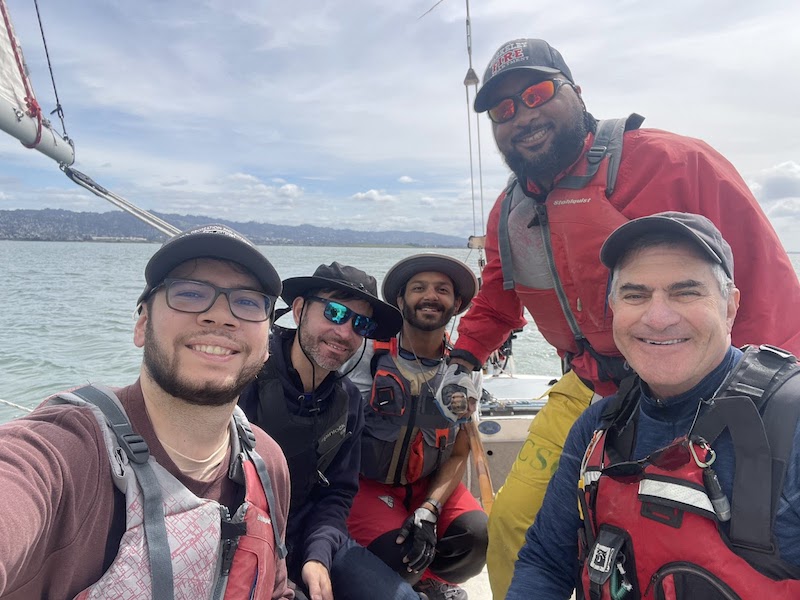
When the resolution was to be voted on by the council, many of the volunteer-run club members attended the meeting in person and online, as they had done on many previous occasions.
“It was also really nice to raise awareness about community sailing, and the fact that anyone can get on the water through this community and learn to sail,” Nicho concluded.
Each year Cal Sailing Club provides more than 2,500 free sailboat rides to new and aspiring sailors. In 2023 alone, they provided 2,942 sailing lessons. Its membership currently stands at over 1,000. The club’s programs are open to everyone through low-cost and no-cost access to membership, and ongoing free community events like monthly open houses, and youth rides.
You can view the final resolution here.
Learn more about Cal Sailing Club and how you can join the program, here.
Crash and Fire in Sausalito and Richardson Bay
It was a dark and (and stormy?) night when there was a crash on Richardson Bay. Then, a couple of weeks later, a small sailboat caught fire on the bay in broad daylight.
At the recent Sausalito Boat Show, a reader stopped by our booth to share a photo he had taken of a Sabre 42 powerboat that had crashed into navigational light #2, a dolphin marking the entrance to the Sausalito channel, late one night. Given the damage to the solidly built boat, it was clearly a high-speed crash. The impact knocked over the pilings and launched the birdcage with markers and light onto the foredeck of the Sabre.

We’ve heard that those on board avoided major injuries, though the boat and the light both need significant repairs. The broken, tipped-over legs of channel marker #2 are below the surface and marked by a floating orange buoy above. It is suggested you give it a wide berth, since the mooring line for the buoy is long, and it’s hard to see what’s below the surface.
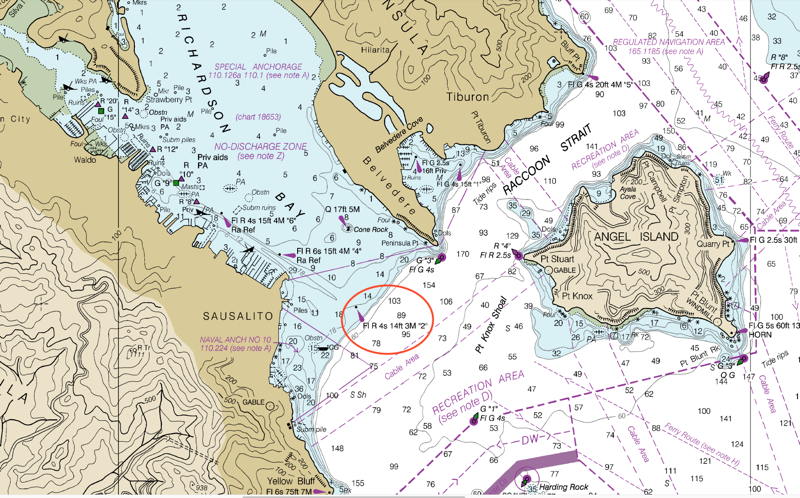
We’re not sure the California Boater Card would have prevented a mishap like this, but it clearly shows the need for ongoing education of boaters. Traveling into busy harbor entrances at night at high speed is not recommended. An operator hitting a well-lit, charted navigation aid has to worry everyone who might be out rowing, kayaking, or sailing under the stars on a properly lit small boat.
In another Richardson Bay incident, a small red Ranger 23 anchored out on Richardson Bay caught fire yesterday afternoon. The Southern Marin fireboat responded and was able to put out the fire before the boat sank.

Apparently there was nobody aboard at the time so no injuries were reported. It is suspected it was an electrical fire.
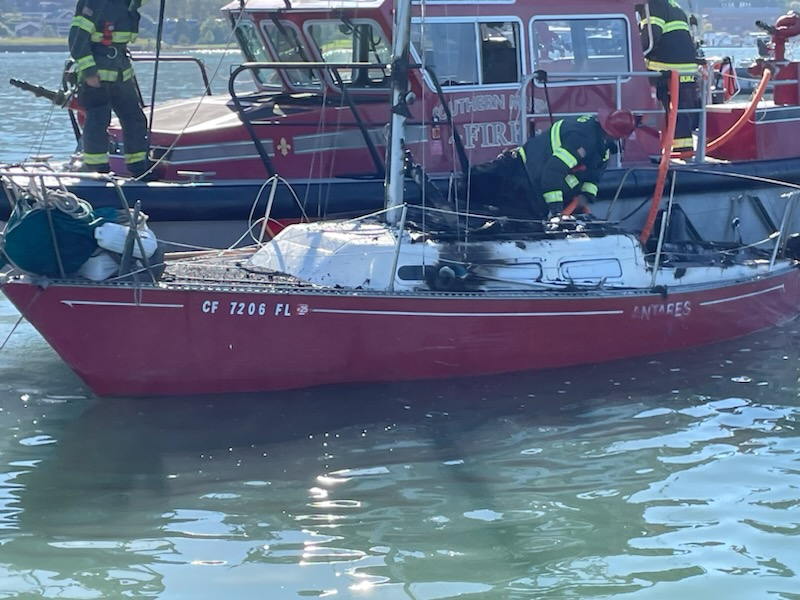
The boat was a relatively recent arrival on Richardson Bay and had been anchored for a couple of weeks. Since this was in excess of the 72-hour legal limit, it had already been cited for code violation and was on the list to be removed.
Fortunately, there was no loss of life in either incident.
One Month Free at Alameda Marina
S.F. Sea Scouts Keep Calm and Sail On
Sailing a proper course at the Belvedere Classic Regatta and Great S.F. Schooner Race on August 10, beside 20 other classic wooden boats, was the Sea Scout whaleboat Corsair with skipper Aaron Wu. “We were doing a big reach, having just rounded Blossom Rock while hitting 8 knots. Assessing it to be a safe time to hand over the tiller, I asked adult leader Celeste McManus to take my place. She held course for a few minutes; then I heard, ‘We have lost our rudder.'” This was a blustery, choppy Bay with a big flood. While Wu wrapped his head around things, McManus called for sails down; in less than 60 seconds, all fabric was folded and tied.
On the eastern side of Alcatraz toward the north end of Treasure Island (but with ample distance from land), Wu opted not to set anchor in the 80- to 90-foot depth. After ensuring safety of all souls on board, he called the Sea Scout base for rescue and tow, then attempted to alert the race committee. The balance of the crew collected thoughts and remained calm, quiet and ready. Meanwhile on the scouts’ other whaleboat, Viking, Michael O’Callaghan tried to communicate with Corsair and the race committee, but the connection cut in and out. Fortunately, one of the RC boats heard the broken call. Visibility was poor over the water, but Corsair was eventually spotted in the distance. Moments after arrival, the SFYC vessel received a tossed line from Corsair. However, it was learned that the Sea Scout tow vessel was having engine troubles en route.
Wu acknowledges that unexpected things can happen in boating, so leaders from the program make sure every scout has the necessary skills to handle challenges. “We have a very interactive program and always want to prepare scouts for emergency situations. Some of the things that we practice are anchoring and capsize drills on the whaleboats. These are essential to our program, as the boats we regularly sail do not have engines and are fairly close to the water. We always try to run drills in controlled environments.” The training paid off.
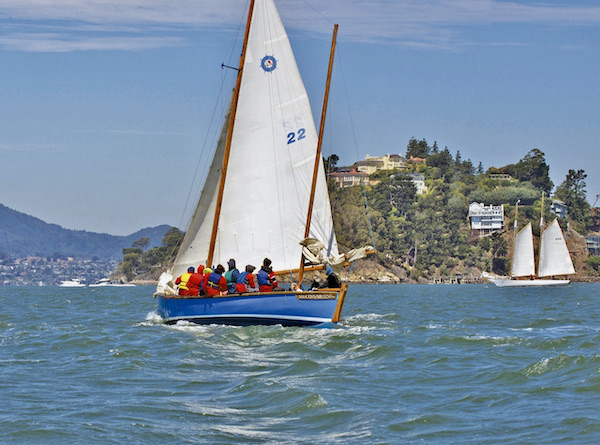
Five-year Sea Scout Aviv was on board Corsair. “Whoa!” was his first thought after learning the rudder had broken. “We all train and prep for things like this, so we felt prepared and had practiced how to keep our cool. We downed sails and unrigged immediately. Everyone was very level about it.” On the quarterdeck, after the sails were lowered, he and crew worked on getting the broken rudder into the boat, then rigging an oar to act as emergency rudder. “I had a lot of friends helping me at that moment. It was a great example of how our crew can keep level heads and quickly respond to emergencies.” He says the depth of experience on board helped everyone remain calm and focused. “We all knew what to do because we train for it; we understood the seriousness of the situation. No one panicked.”
Miles, in the program for three-and-a-half years, assisted with sails, then listened to calls to Sea Scout base and race committee check-in. During this time, he and crew also did what they could to safely retrieve the paddle portion of the rudder — but it was drifting away quickly. This scout was instrumental in helping Corsair get secure back at Aquatic Park. “While nearing the dock and still under tow, our boat was coming in at a weird angle, and the cast-off from Vashon was made too early,” explains Miles. “We tried to row into position, but the current was pushing too much. “I got on an oar really quick, and helped get everyone focused on rowing properly until we could pick up the towline again.”
Also rising to the occasion was Patrick Martin, quartermaster adult leader. While under tow, Martin troubleshot the engine over the phone. Before transferring to a temporarily anchored Vashon, he and the adult lead on Vashon “walked through several steps, so by the time I got onto the 22-ft training boat White Crane, we had narrowed it down to something simple.” The RC boat was informed, and the possible need to tow a second vessel was understood. Upon mark-set boat approach, crews secured lines to connect vessels and Martin transferred. A quick fix was made and verified, then a call for cast-off from the mark-set boat was made. Moments later, all were underway. Facing its own challenges, White Crane crew also tapped their training, adroitly following instructions and keeping calm. Speaking about his moments on Corsair, Martin reiterates, “Everyone moved quickly and efficiently during the incident. The boat was quiet other than those giving instructions.”
O’Callaghan is senior license examiner with the Golden Gate Area Council of the Sea Scouts. Not wishing to cast any aspersions on Wu, he says he built the failed rudder and has fashioned its replacement, changing the design by using laminated wood reinforced with fiberglass.
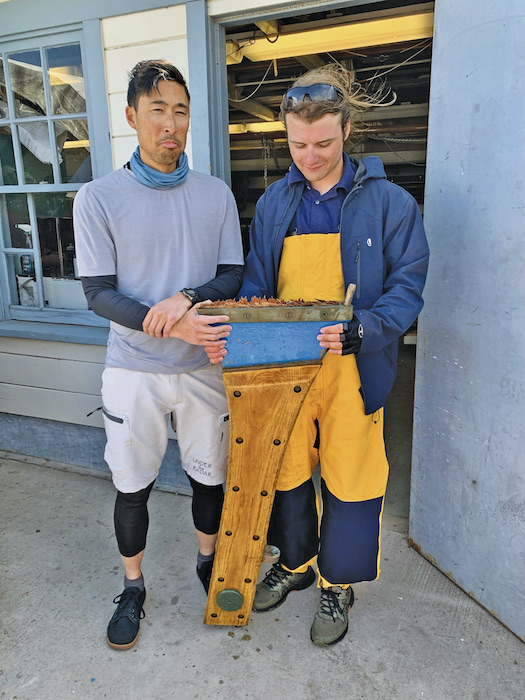
In his 52 years as a leader, O’Callaghan has witnessed countless moments of joy and merit. Speaking of merits, scout Miles says, “I have many friends here and we do fun activities every week. I’ve learned about piloting, navigation, and good boating instincts on the water. I’ve learned about both engines and sailing, applicable to stuff outside of scouts, too.” Mate Aviv lists his merits: “I tend to be more of a leader in situations outside of scouts now. I’ve made a lot of friends in the program, and we all encourage each other. Camaraderie keeps me coming back.”
Read more short sailing stories in October’s Sightings.
- Racing
- International Racing
- Latitude 38 Magazine
- West Coast Sailing
- Northern California Racing
- General Sailing
Melges 24 World Championship — A Brisk Battle
San Francisco Bay is often a long way to travel to in order to compete in a class world championship, but smart sailors know it’s worth it. This year, the always-competitive and high-performance Melges 24 class traveled here to have their world championship, hosted by the San Francisco Yacht Club (SFYC). It was a hotly contested event raced on a breezy, sparkling Berkeley Circle.
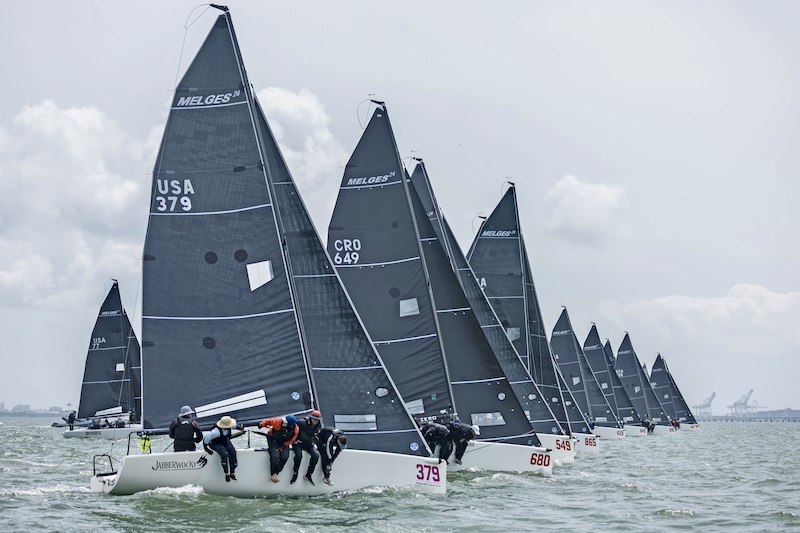
After everyone came in off the rails of the last race, two Midwestern teams and one California team took the top three podium positions. Don Wilson and his Convexity team from the Chicago Yacht Club captured the 2024 Diversified Melges 24 World Champions title. Racing with Wilson were tactician Jeremy Wilmot and crew members Ian Liberty, Edward Hackney, and Tomas Dietrich. They worked hard and pulled it off with a single point separating them from the second-place finisher.
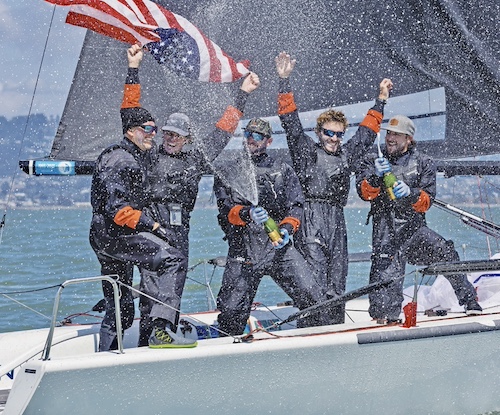
In second place was 2009 US Sailing Rolex Yachtsman of the Year Bora Gulari, from Bayview Yacht Club in Detroit, with his crew aboard Kingspoke. Recently crowned US National Champion Geoff Fargo, helming Sentinel from the Santa Barbara Yacht Club, locked in a solid third-place finish.

The Corinthian Division was won for the second year in a row by Ante Botica and his crew, Ivo Matic, Mario Skrlj, Samir Civadelic and Boris Bakotic, all of whom traveled from Croatia to win aboard Mataran 24. The last US winner of the Corinthian Division was San Francisco Yacht Club staff commodore Don Jesberg, who won the event when it was last hosted by SFYC in 2013. Second place in the Corinthian Division (15th overall) was Duane Yoslov’s Looper with his crew: his son Caleb Yoslov, James Golden, Ellise Smolenyak and Noah Barrengos. Kent Pierce’s Average, with crew David Ryan Eastwood, Eric Stokke, Claire Hunt and Tristan Richmond, from the Santa Barbara Yacht Club, placed third in Corinthian (16th overall).
The final one-point separation at the top of the fleet wasn’t settled until Wilson and Gulari battled it out in the last two races of the event. After four days of fiercely competitive, windy racing on the Berkeley Circle, the fifth and final day delivered a dramatic showdown between Convexity and Kingspoke. With only one point separating the two, the stakes were sky-high going into the final race.


